Anatomy of the Forearm: Exploring the Bones of the Forearm

Introduction to Forearm Anatomy
Welcome to my anatomy series on the upper limb. Today, let's look at the world of our forearm bones. These aren't just any bones; they're the structures that allow us to twist our wrists, wave hello, and lift our favorite cup of coffee. The forearm consists of two long bones, the radius and the ulna. These bones run side by side from the elbow to the wrist. The radius is on the thumb side, and the ulna is on the little finger side. Together, they form the radioulnar joint, which is responsible for the supination and pronation of our hand – that's the turning motion of our wrist.
The Importance of Understanding Forearm Anatomy
Understanding the anatomy of the forearm is crucial, not just for medical professionals, but for anyone interested in how their body works. It's especially important for athletes, artists, and musicians, whose forearms play a key role in their activities. Knowing about the bones, muscles, nerves, and blood vessels can help us appreciate the complexity and design of our bodies, and guide us in taking care of this see segment of our body.
In this article, we'll explore the anatomy that takes place within the small confines of our forearm. We'll cover the bones, the muscles that power them, the nerves that weave through them like threads of sensation, and the blood vessels that keeps the whole compartment of the foreman running. So, whether you're a curious soul or a budding anatomist, by the end of this section, you'll uncover the structures of the forearm.
Structure of the Forearm Bone
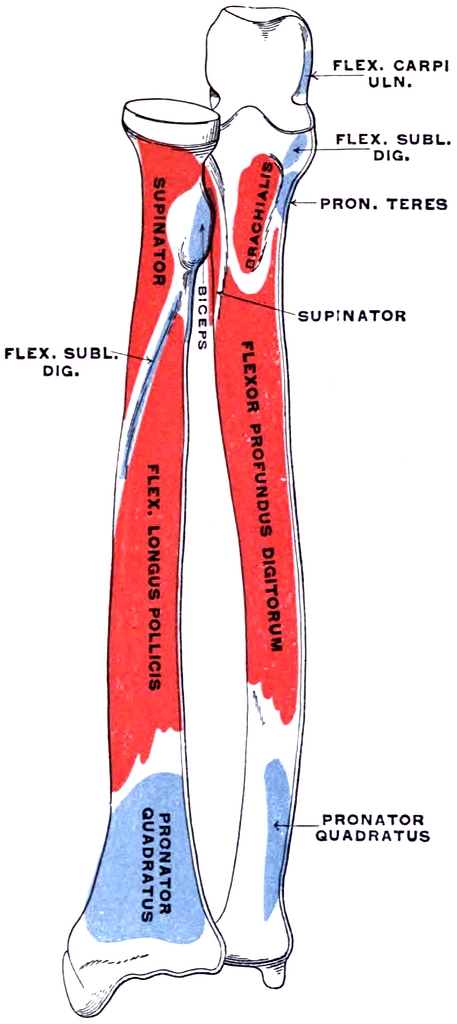
The forearm is a home to two long bones, the radius and the ulna. These are the skeletal bones that make up the lower part of our arm.
Location of the Forearm Bones in the Arm
The radius and ulna span the space from our elbow to our wrist. The radius is located on the thumb side, while the ulna finds its place on the side of the little finger. They are parallel to each other and connected by the interosseous membrane.
Composition and Function of the Forearm Bones
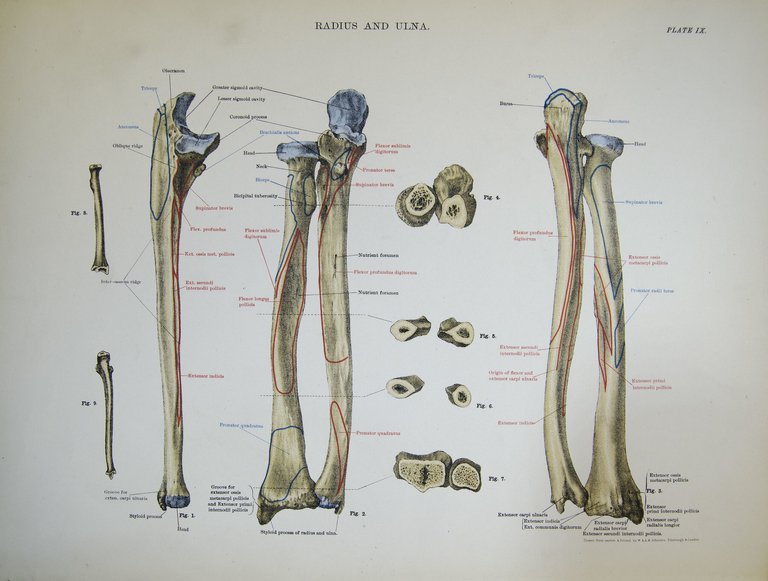
The radius and ulna are made up of compact bone tissue, which gives them the strength to withstand the forces we exert during activities. The radius allows us to turn our palms up and down, thanks to its ability to rotate around the ulna. The ulna, with its hook-like structure at the elbow, acts as a stabilizing pivot. Together, they support the muscles that control our wrist and fingers, enabling us to grip, lift, and manipulate objects with precision.
Anatomy of the Radius
The radius is one of the two long bones in the forearm, situated on the lateral side when in the anatomical position. It's a pivotal part of our arm's structure, enabling a range of movements at the wrist and elbow.
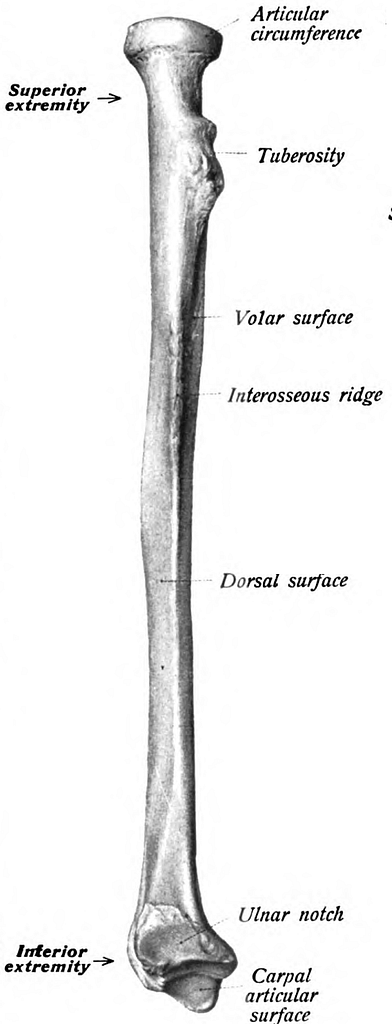
Proximal and Distal Ends of the Radius
At its proximal end, the radius features a disk-shaped head that articulates with the capitulum of the humerus and the radial notch of the ulna. The distal end expands to form a rectangular shape, which includes the styloid process and articulates with the carpal bones to form the wrist joint¹.
Features and Landmarks of the Radius Bone
The radius has several key landmarks:
- Radial tuberosity: A bony projection for the attachment of the biceps brachii muscle.
- Interosseous border: A ridge for the attachment of the interosseous membrane.
- Styloid process: A bony projection at the distal end, providing attachment for ligaments of the wrist.
Articulations of the Radius with Other Bones
The radius articulates with:
- The humerus at the elbow joint.
- The ulna at the proximal and distal radioulnar joints.
- The carpal bones (scaphoid and lunate) at the wrist joint.
Anatomy of the Ulna
The ulna is the medial and longer bone of the forearm, extending parallel to the radius. It plays a vital role as the stabilizing structure, with the radius pivoting to produce movement.
Proximal and Distal Ends of the Ulna
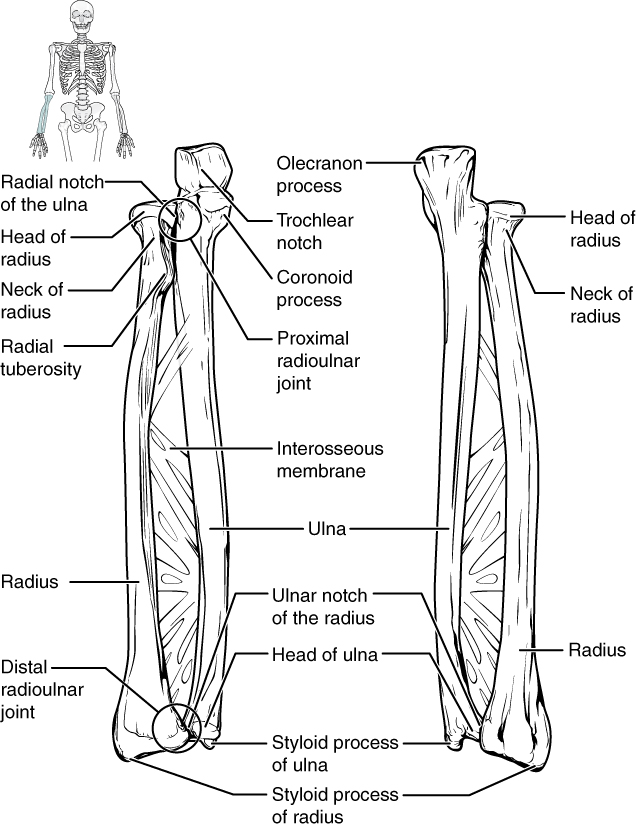
Proximally, the ulna features the olecranon, which forms the elbow's tip, and the coronoid process, which together with the olecranon, creates the trochlear notch for articulation with the humerus. Distally, it ends in a smaller, rounded head with a projection known as the ulnar styloid process.
Features and Landmarks of the Ulna Bone
The ulna has several notable features:
- Olecranon: The elbow's point, where the triceps brachii muscle attaches.
- Coronoid process: Anterior projection forming part of the trochlear notch.
- Trochlear notch: Wrench-shaped structure articulating with the humerus.
- Radial notch: Lateral surface articulation with the radius.
- Ulnar tuberosity: Below the coronoid process, where the brachialis muscle attaches.
Articulations of the Ulna with Other Bones
The ulna articulates with the humerus at the elbow joint and with the radius at the proximal and distal radioulnar joints, forming part of the elbow and the wrist joint, respectively.
Joints of the Forearm
The forearm is a complex region that allows for a variety of movements thanks to its joints. Here's a detailed look at the joints and the movements they permit:
Elbow Joint (Humeroulnar and Humeroradial Joints)
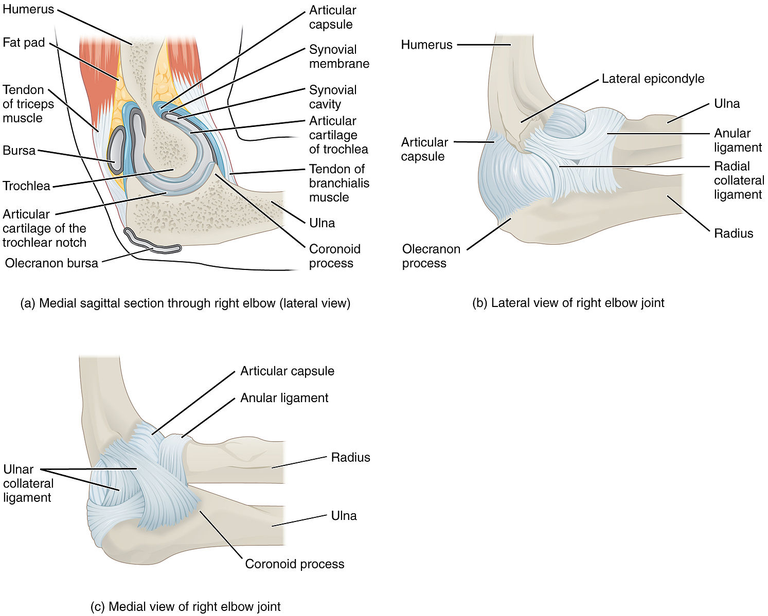
The elbow joint is a synovial hinge joint formed by the articulation of three bones: the humerus of the arm, and the radius and ulna of the forearm. It allows for two main movements:
- Flexion: Bending the elbow, decreasing the angle between the arm and forearm.
- Extension: Straightening the elbow, increasing the angle between the arm and forearm.
Proximal Radioulnar Joint
This joint is located near the elbow and is a pivot-type synovial joint. It allows for the rotation of the radius around the ulna, which results in:
- Pronation: Turning the forearm so the palm faces downwards.
- Supination: Turning the forearm so the palm faces upwards.
Distal Radioulnar Joint
Located near the wrist, this pivot joint allows for similar movements as the proximal radioulnar joint:
- Pronation: The radius moves over the ulna, turning the hand so the palm faces down.
- Supination: The radius moves back to its anatomical position next to the ulna, turning the hand so the palm faces up.
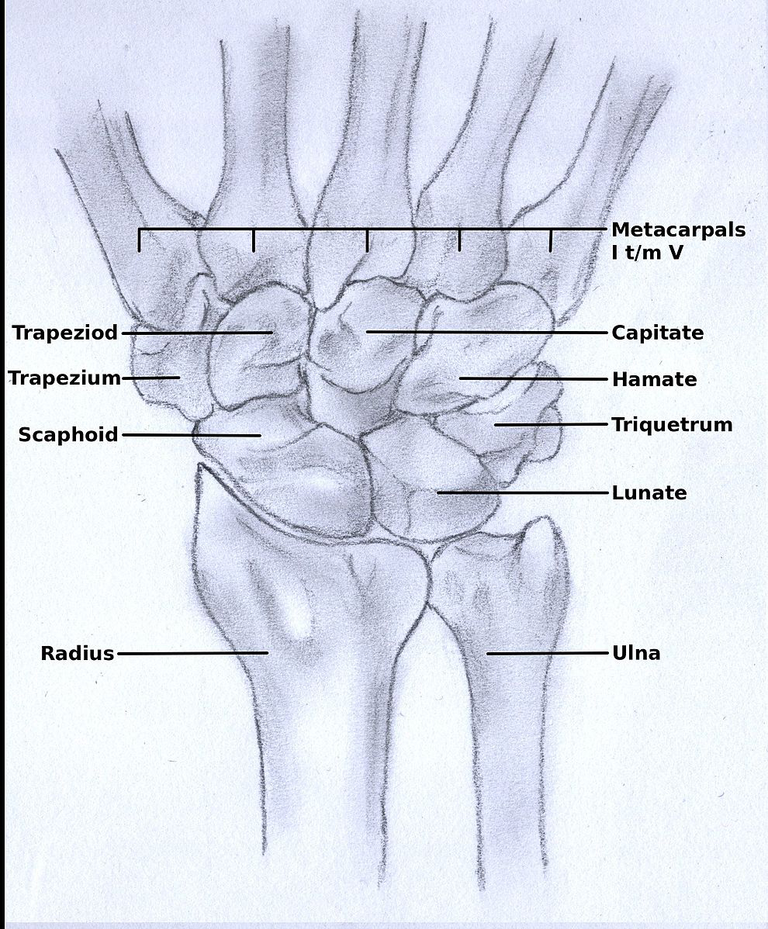
These joints work in tandem to allow the hand to rotate about the forearm in a movement unique to the upper limb, providing great dexterity and range of motion.
Muscle Attachments and Function in the Forearm
Flexors and Extensors of the Forearm
The forearm muscles are divided into two compartments: the anterior compartment contains the flexors, and the posterior compartment houses the extensors. The **flexors** are primarily responsible for bending the wrist and fingers, while the **extensors** straighten them out.Flexors:
- Superficial: Includes muscles like the flexor carpi ulnaris and palmaris longus.
- Intermediate: Contains the flexor digitorum superficialis.
- Deep: Houses the flexor pollicis longus and pronator quadratus.
Extensors:
- Superficial: Includes muscles like the extensor carpi radialis longus and extensor digitorum.
- Deep: Contains muscles such as the supinator and abductor pollicis longus.
Pronators and Supinators of the Forearm
The forearm also contains muscles specifically for pronation and supination:
- Pronators: Pronator teres and pronator quadratus rotate the forearm to turn the palm downwards.
- Supinators: The supinator and biceps brachii rotate the forearm to turn the palm upwards.
Role of Forearm Muscles in Daily Activities
Forearm muscles play a crucial role in daily activities. They are involved in gripping, lifting, and carrying objects. These muscles are also essential in sports that require hand and arm strength, such as rock climbing, tennis, and golf. They help in tasks such as opening jars, typing on a keyboard, and even simple gestures like waving.
Blood Supply and Nerve Innervation of the Forearm
Arteries Supplying the Forearm Bone
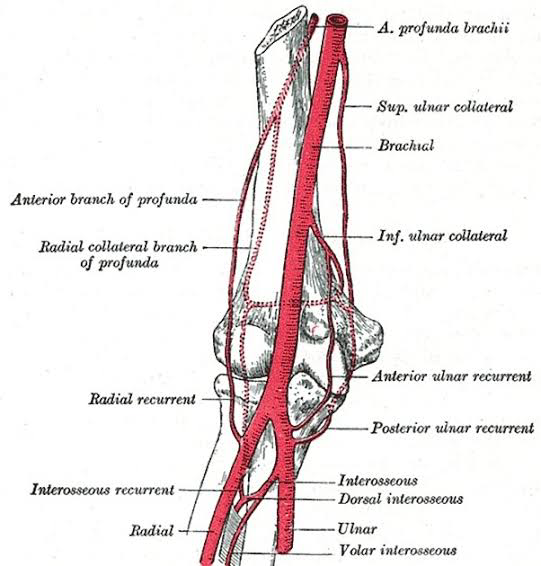
The arterial supply to the forearm is primarily through the radial and ulnar arteries. These major vessels arise from the bifurcation of the brachial artery at the elbow. The radial artery travels along the lateral aspect of the forearm, while the ulnar artery runs medially. They both provide essential blood flow to the forearm's muscles and bones, ensuring the delivery of oxygen and nutrients.
Nerves Innervating the Forearm Muscles
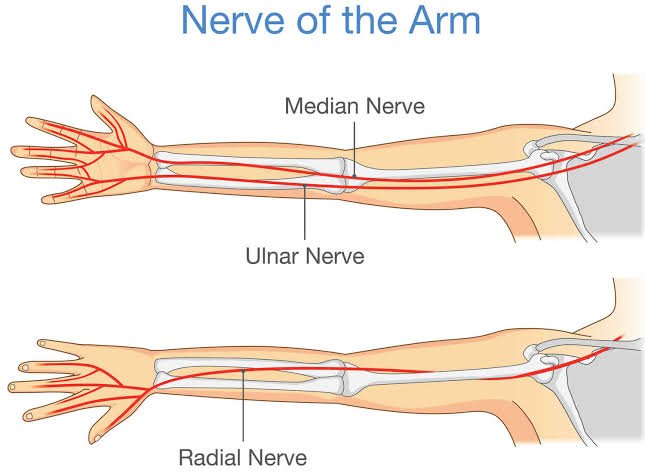
The nerves that innervate the forearm muscles include:
- Median nerve: Innervates most of the flexor muscles.
- Ulnar nerve: Supplies motor innervation to the medial flexor digitorum profundus and flexor carpi ulnaris.
- Radial nerve: Innervates the extensor muscles of the forearm.
These nerves originate from the brachial plexus and are crucial for the sensory and motor functions of the forearm.
Importance of Proper Blood Supply and Nerve Function for Forearm Health
Adequate blood supply and proper nerve function are vital for maintaining the health of the forearm. The blood vessels ensure the delivery of oxygen and nutrients, which are essential for muscle function and bone health. Nerves provide the electrical signals that control muscle movements and convey sensory information. Any disruption in these systems can lead to muscle weakness, loss of sensation, or even more severe conditions like compartment syndrome or peripheral neuropathy.
Maintaining good vascular and neural health is necessary for the overall functionality of the forearm, enabling us to perform daily activities with ease and precision.
Common Injuries and Conditions of the Forearm
Fractures of the Radius and Ulna
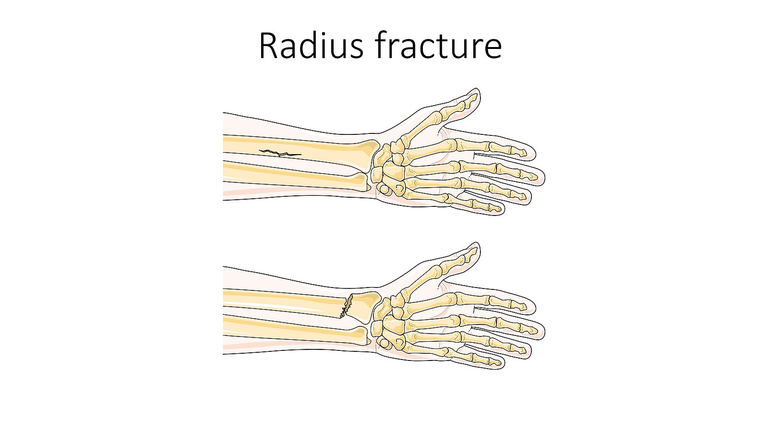
Fractures of the radius and ulna, the two long bones in the forearm, are among the most common bone injuries. These fractures can occur due to falls, direct impacts, or accidents. Symptoms include immediate and intense pain, swelling, and sometimes an obvious deformity if the bones are displaced.
Tennis Elbow (Lateral Epicondylitis)
Tennis elbow, or lateral epicondylitis, is a painful condition of the tendons in the elbow caused by overuse. This typically occurs in individuals who engage in activities that require repetitive arm and wrist movements. Symptoms include pain and tenderness on the outside of the elbow, which may extend into the forearm and wrist.
Carpal Tunnel Syndrome
Carpal tunnel syndrome is characterized by numbness, tingling, and pain in the hand and arm, caused by pressure on the median nerve in the wrist. This condition often arises from repetitive motions or anatomical factors that reduce the space within the carpal tunnel, compressing the nerve.
Treatment Options for Forearm Injuries and Conditions
Treatment for forearm injuries and conditions varies depending on the severity and cause. Options include:
For Fractures:
- Nonsurgical: Immobilization with casts or splints.
- Surgical: Open reduction and internal fixation with plates and screws may be necessary for severe fractures.
For Tennis Elbow:
- Medication: NSAIDs for pain relief.
- Therapy: Physical therapy and exercises.
- Procedures: In severe cases, surgery or ultrasonic tenotomy might be recommended.
For Carpal Tunnel Syndrome:
- Medication: NSAIDs or corticosteroids for pain and inflammation.
- Procedures: Surgical options include endoscopic surgery or open palm surgery to relieve pressure on the median nerve.
General Treatments:
- Physical Therapy: Exercises to improve function and mobility.
- Braces and Splints: To immobilize the affected area and limit movements that worsen the condition.
It's important to consult with a healthcare professional for a proper diagnosis and to determine the most appropriate treatment plan for any forearm injury or condition.
Let's Recap Key Points Covered in the Article
In this comprehensive exploration, we've delved into the intricate anatomy of the forearm, starting with the radius and ulna bones that form the skeletal framework. We have examined their structure, the joints they form, and the movements they facilitate. We've also highlighted the muscles that animate the forearm, enabling flexion, extension, pronation, and supination. Furthermore, we have discussed the critical role of the neurovascular system in forearm health and function, and touched upon common injuries and conditions that can affect this complex anatomical region.
It's been a pleasure guiding you through the anatomy of the forearm. Remember, our bodies are like machines, and the more we learn about them, the better we get to appreciate and care for them.
Thanks for following up till this last section of the article. See you on the other side😁
References
(1) Radius and ulna fractures: Types, treatment, and rehabilitation. https://www.medicalnewstoday.com/articles/radius-ulna-fracture.
(2) Diagnosis of Tennis elbow and what are its different treatment options?. https://www.msn.com/en-us/health/condition/Tennis-elbow/hp-Tennis-elbow?source=conditioncdx.
(3) Diagnosis of Carpal tunnel syndrome and what are its different treatment options?. https://www.msn.com/en-us/health/condition/Carpal-tunnel-syndrome/hp-Carpal-tunnel-syndrome?source=conditioncdx.
(4) Radius and Ulnar Shaft Fractures - Trauma - Orthobullets. https://www.orthobullets.com/trauma/1025/radius-and-ulnar-shaft-fractures.
(5) Tennis elbow - Diagnosis and treatment - Mayo Clinic. https://www.mayoclinic.org/diseases-conditions/tennis-elbow/diagnosis-treatment/drc-20351991.
(6) Carpal tunnel syndrome - Diagnosis and treatment - Mayo Clinic. https://www.mayoclinic.org/diseases-conditions/carpal-tunnel-syndrome/diagnosis-treatment/drc-20355608.
(7) Forearm Pain: Causes, Treatment, and Symptoms - Healthline. https://www.healthline.com/health/forearm-pain.
(8) Forearm Pain: How to Relieve Inner or Outer Soreness - Verywell Health. https://www.verywellhealth.com/forearm-pain-8599897.
(9) Forearm pain: Causes, exercises, and stretches - Medical News Today. https://www.medicalnewstoday.com/articles/320782.
(10) Carpal Tunnel Syndrome - Symptoms and Treatment - OrthoInfo. https://orthoinfo.aaos.org/en/diseases--conditions/carpal-tunnel-syndrome/.
(11) Common Fractures of the Radius and Ulna | AAFP. https://www.aafp.org/pubs/afp/issues/2021/0315/p345.html.
(12) Tennis Elbow: What It Is, Causes, Symptoms & Treatment - Cleveland Clinic. https://my.clevelandclinic.org/health/diseases/7049-tennis-elbow-lateral-epicondylitis.
(13) Getty Images. https://www.gettyimages.com/detail/photo/woman-hand-with-french-manicure-gesturing-isolated-royalty-free-image/1281235185.
(14) Arterial supply of the upper limb | Radiology Reference Article .... https://radiopaedia.org/articles/arterial-supply-of-the-upper-limb?lang=us.
(15) Upper limb: Arteries, veins and nerves | Kenhub. https://www.kenhub.com/en/library/anatomy/neurovasculature-of-the-upper-limb.
(16) Vessels and nerves of the forearm: Video & Anatomy | Osmosis. https://www.osmosis.org/learn/Vessels_and_nerves_of_the_forearm.
(17) Ulnar nerve: Origin, course, branches and innervation | Kenhub. https://www.kenhub.com/en/library/anatomy/the-ulnar-nerve.
(18) Nerves of Forearm (Left) | Complete Anatomy - Elsevier. https://www.elsevier.com/resources/anatomy/nervous-system/peripheral-nervous-system/nerves-of-forearm-left/22695.
(19) Elbow and forearm: Forearm muscles and bones anatomy | Kenhub. https://www.kenhub.com/en/library/anatomy/elbow-and-forearm.
(20) Muscles of the Anterior Forearm - Flexion - TeachMeAnatomy. https://teachmeanatomy.info/upper-limb/muscles/anterior-forearm/.
(21) Pronation and supination: Anatomy, definition, images | Kenhub. https://www.kenhub.com/en/library/anatomy/pronation-and-supination.
(22) Supinator: Origin, insertion and action | Kenhub. https://www.kenhub.com/en/library/anatomy/supinator-muscle.
(23) Forearm Muscles: Anatomy, Function, & Exercises - WebMD. https://www.webmd.com/fitness-exercise/forearm-muscles-what-to-know.
exercises.
(24) Forearm Pronation & Supination: Muscles, Bones, & Joints - Innerbody. https://www.innerbody.com/image/musc03.html.
(25) Elbow joint: Anatomy, ligaments, movements, blood supply | Kenhub. https://www.kenhub.com/en/library/anatomy/elbow-joint.
(26) Proximal radioulnar joint: Anatomy, movements | Kenhub. https://www.kenhub.com/en/library/anatomy/proximal-radioulnar-joint.
(27) Distal radioulnar joint: Anatomy, movements | Kenhub. https://www.kenhub.com/en/library/anatomy/distal-radioulnar-joint.
(28) The Elbow Joint - Structure - Movement - TeachMeAnatomy. https://teachmeanatomy.info/upper-limb/joints/elbow-joint/.
(29) Elbow Joint: Anatomy, Function & Common Conditions - Cleveland Clinic. https://my.clevelandclinic.org/health/body/elbow-joint.
(30) Types of joint movement in the skeletal system - Skeletal system ... - BBC. https://www.bbc.co.uk/bitesize/guides/zq3sbk7/revision/4.
(31) The Ulna - Proximal - Shaft - Distal - TeachMeAnatomy. https://teachmeanatomy.info/upper-limb/bones/ulna/.
(32) Ulna (Bone): Anatomy, Location & Function - Cleveland Clinic. https://my.clevelandclinic.org/health/body/24520-ulna.
(33) Ulna | Radius, Forearm, & Bones | Britannica. https://www.britannica.com/science/ulna.
(34) Radius and ulna: Anatomy and function | Kenhub. https://www.kenhub.com/en/library/anatomy/the-radius-and-the-ulna.
(35) en.wikipedia.org. https://en.wikipedia.org/wiki/Ulna.
(36) The Radius - Proximal - Distal - Shaft - TeachMeAnatomy. https://teachmeanatomy.info/upper-limb/bones/radius/.
(37) Radius and ulna: Anatomy and function | Kenhub. https://www.kenhub.com/en/library/anatomy/the-radius-and-the-ulna.
(38) Radius (Bone): Anatomy, Location & Function - Cleveland Clinic. https://my.clevelandclinic.org/health/body/24528-radius.
(39) en.wikipedia.org. https://en.wikipedia.org/wiki/Radius_(bone).




A good write up, please I have a question regarding the cause of the tennis elbow. You said excessive movement of the elbow is the major cause of the condition. For those that go to the gym on a regular basis which leads to excessive movement of the joint as a result of lifting heavy weights, do it pose a risk for the condition? Thank you very much
Ok. That's slightly different from overuse. When you gym, you don't overuse your joints. There are sensors around the joints that keep us posted when we are about to overuse the joints. so during gym, you're typically aware of this. Situation which can lead to lateral epicondylitis include playing tennis. It's a sport that involves excessive movement of tendons and muscles around the elbow joint.
Please note that this problem is not common.
Okay
Tennis
Wow, thank you ☺️☺️
Thanks for your contribution to the STEMsocial community. Feel free to join us on discord to get to know the rest of us!
Please consider delegating to the @stemsocial account (85% of the curation rewards are returned).
You may also include @stemsocial as a beneficiary of the rewards of this post to get a stronger support.